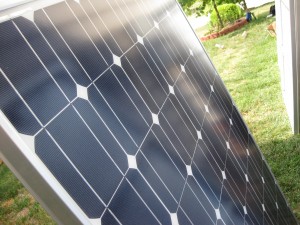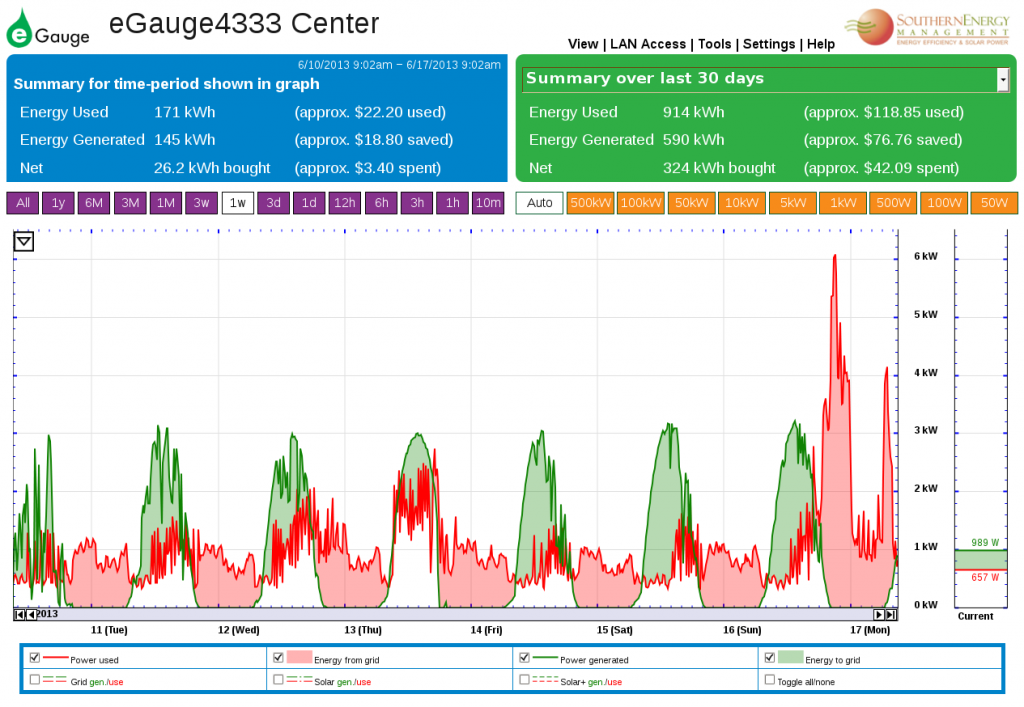 On July 2, 2010, the photo voltaic system installed on our roof by Southern Energy Management that included 18 solar panels was turned on. We finally started generating renewable energy. I looked at the project as a long-term investment, not a quick way to make money. But overall, the right thing to do for the environment.
On July 2, 2010, the photo voltaic system installed on our roof by Southern Energy Management that included 18 solar panels was turned on. We finally started generating renewable energy. I looked at the project as a long-term investment, not a quick way to make money. But overall, the right thing to do for the environment.
I was inspired by Thomas S. Friedman’s Hot Flat and Crowded. In the book, he says that there should be solar panels on every rooftop in America. So we found a great company to partner with and we did our part. Not quite an early adopter, but jumping on the bandwagon.
I get a lot of questions about how much the system costs and how it works. It seems like a good time to share this information (as I’ve been meaning to for a long time). Plus, I saw a post that June was solar energy month in NC and decided to share our story.
The project included 18 panels, an AC/DC converter, and installation. It was $26,000.00. We were able to take advantage of both Federal and State tax incentives. In the first year, we got $13,836.00 back in tax credits and then $3,074.00 in 2011. Within the first year, half the system was paid for in tax breaks. In total, we got almost $17,000 back in incentives.
We sell all of our power to “the grid.” I signed a five-year contract with Progress Energy (now Duke Progress Energy) and we make $0.265 per kiloWatt hour. To put that into perspective, we have been purchasing power at the rate of 11 cents per kiloWatt hour.
Return on Investment
If you ever look at getting solar panels installed, you’ll want to pay attention to your ROI or your Return on Investment. Our estimate, including tax incentives and power generation, was 8.5 years. We are on that track right now. To date, we’ve generated almost $4,000.00 in power.
Earlier this year, we had an e-gauge installed to monitor our power usage (see below). That was about $750.00. And it’s real time. It shows both our power generation and power consumption. What a great learning tool to show us how much major appliances like the HVAC, dryer, and stove, are such power hogs. But we also see how much we generate, which is cool too. Did I mention how much power the dryer uses?
From an ROI perspective, we still need to pay off $5,800 dollar on the initial investment. We are currently generating about $1,400 in power a year. We are on target to pay off the system in four years and the system has a 25-year life span. Hopefully, in 2017, we’ll be making money on our investment moving forward. (As long as the sun keeps shining!)
Solar Renewable Energy Credits
One of the ways that we make money through power generation is through Solar Renewable Energy Credits or SRECs. We get quarterly checks for every 1 MegaWatt hour of power produced. We get paid $200 for every each SREC. Sometimes we’ll get a check for $200, other times $400. It really depends on how much the sun is shining and the temperature.
We get our SRECs from a company out of Maryland who “buys” power from power generating facilities like ours, and resells it to power companies who need renewable energy credits—meaning that power company isn’t generating enough of their own renewable energy. So far, we’re making a minimum of $1,000 a year in SRECs. We also get an annual check from the power company that been around $300.
2011 and 2012 were the first two full years of solar generation and power consumption. In 2011, our annual power bill was $1,358.44 and we generated $1,326.24 in solar power. The difference was $32.20. In 2012, we actually “made money.” Our annual power bill was $1,389.26, we generated $1,689.61 in power, and came out on the plus side with ($300.35) in our favor.
Being more sustainable
That’s pretty much where we are at with our solar power system. The back of our roof is for water collection and we have a 750 gallon cistern system collecting rain water. Sun in the front, water in the back.
In the fall of 2011, we installed St Augustine grass—a summer turf— in our yard. We rarely water our yard and we love it. Slowly but surely, we’re working to make our small portion of the world more sustainable, renewable, and environmentally friendly. Let me know if you have any questions. I really enjoy talking about our solar power system, cistern system, and you know we have chickens now. Yeah, ask about our urban chicken farm.


Any pushback from Duke Progress yet, in terms of your “freeloading” on their infrastructure? Many utilities around the country are trying to eliminate net metering based on this charge.
And I notice you’re selling power at $0.265 per kiloWatt hour, buying at 11 cents per kiloWatt hour. Yet you’re also selling your maximum power at peak times, in the late afternoon, when air conditioners are on high. I think Duke Progress gets a lot more than 11 cents kwh for that power.
I have a five year contract with Duke Progress, so I guess I’ll find out in two years. From other folks I’ve talked to that have gotten more recent PV installations, the model is a little different now than the type of contract I’m on.
Pingback: Renewable Energy: Let's All Fail Like This | RocketNews
Way to go! Case histories are always more instructive and useful than rule of thumb generalities. Especially the information here on SRECs which should be of interest to homeowners considering solar electric.
Getting back to Dana’s comment above. Are you sure you don’t mean to say that you are selling power back to Duke at the rate of $0.0265 (2 1/2 cents) per kWh rather than $0.265 (26 cents)?
Hi Sam, I think the way it breaks down is that I sell a portion of each kWh to the power company and the other portion to the company who provides the SRECs. Let me go back and look at my contract to be sure.
Sam,
I looked at the contract I signed with Progress Energy (now Duke Energy). It’s called a Cogeneration and small power produce schedule (CSP-25 is the name of their doucment).
I couldn’t find anything that specified the rate that I mentioned above, I just remember that Southern Energy told me I would be selling power back at 26 cents per kWh. Maybe this is some sort of average they came up with? I’ll keep digging where that number came from.
The contract breaks it down into Energy Credits and Capacity Credits.
Energy credits (5-year fixed rate)
Capacity credits (5-year fixed rate)
Pingback: Renewable energy: Let's all fail like this | RocketNews
Someone on Twitter asked me about the tax incentives. I found this site which outlines some of the tax credits available for energy from the federal government: http://www.energystar.gov/index.cfm?c=tax_credits.tx_index
I would advise consulting your CPA before assuming the credits can be applied for tax filing purposes.